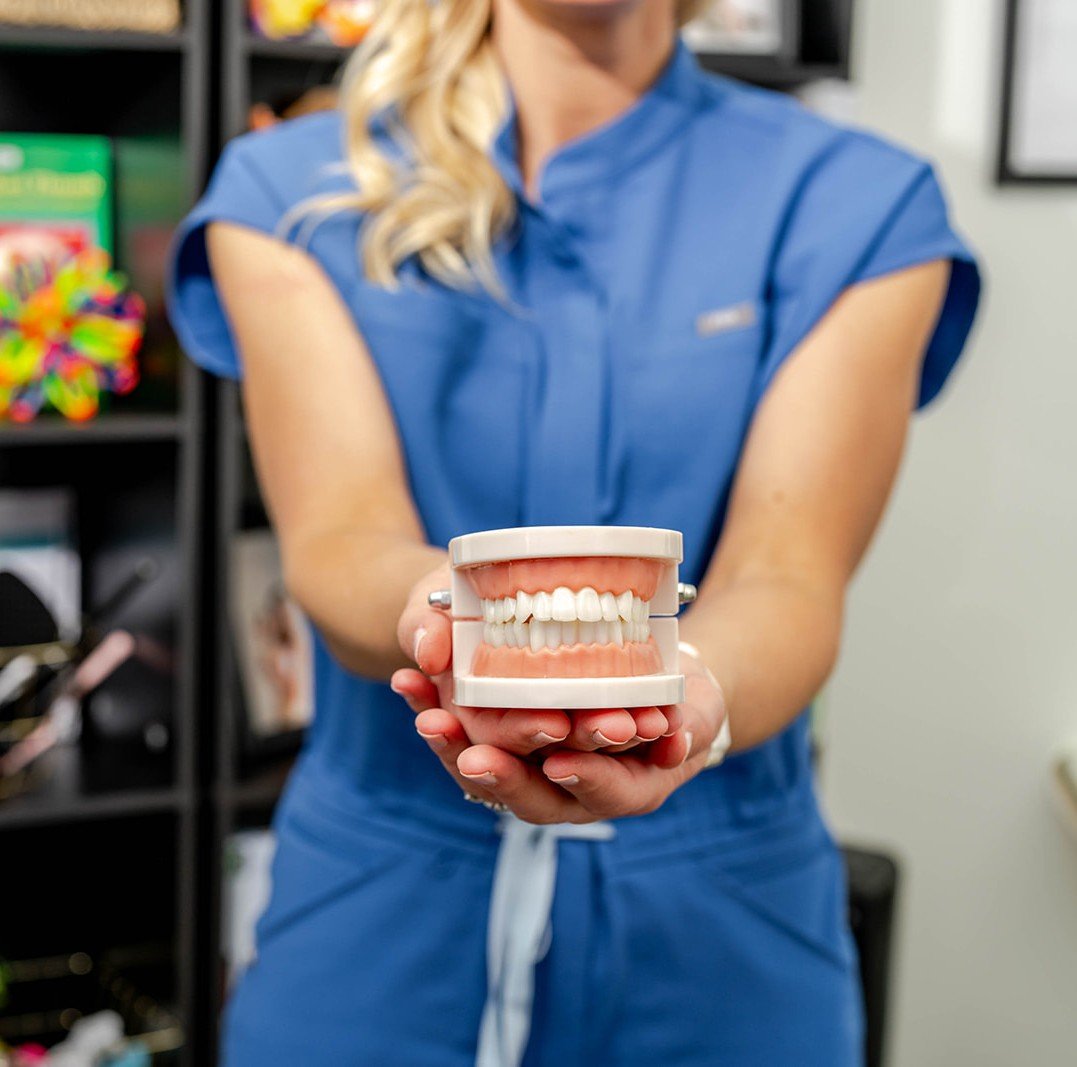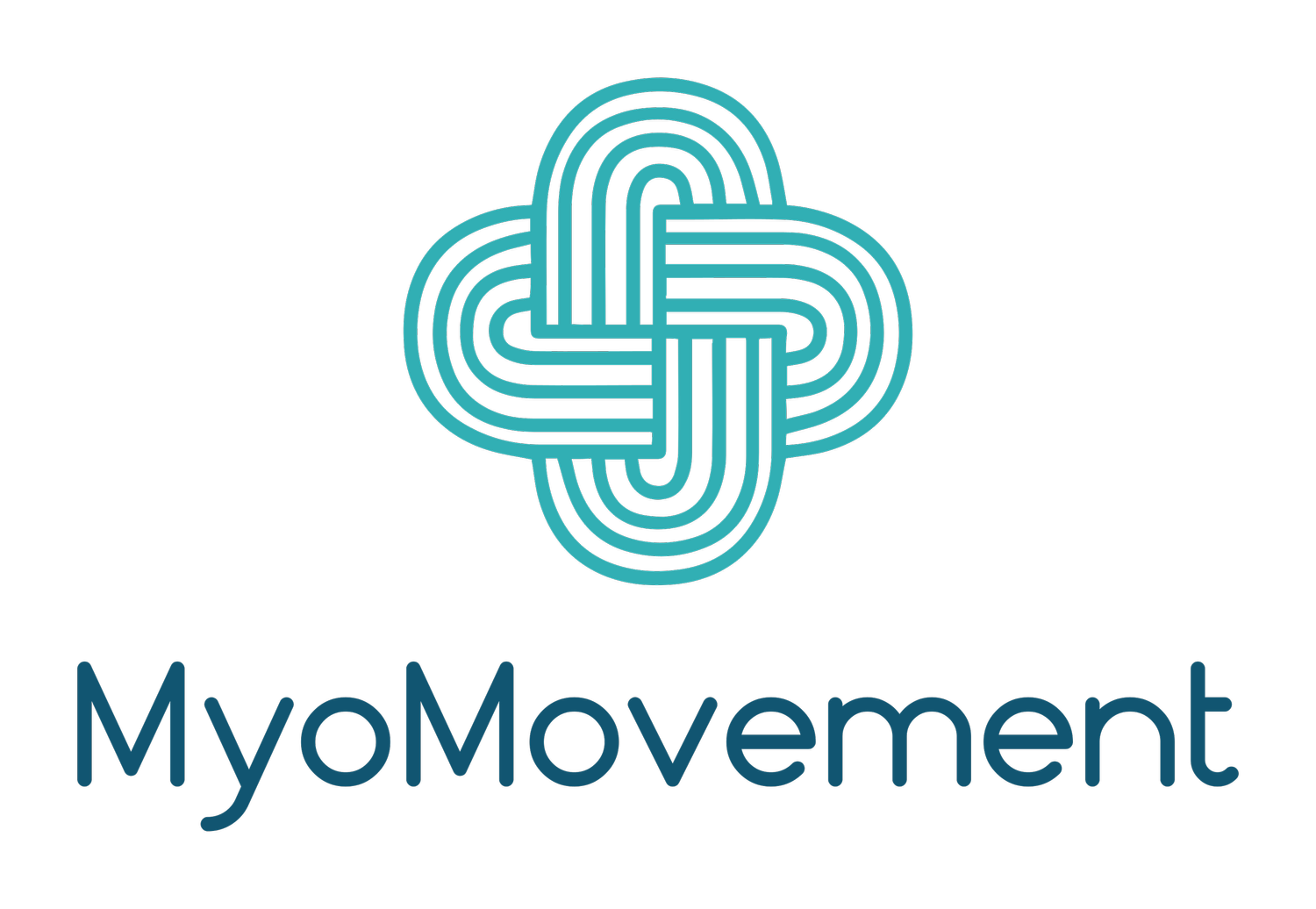
Could I benefit from Myofunctional Therapy?
What is it?
Benefits of Myofunctional Therapy
-
elimination of mouth breathing, promoting nasal breathing reduction in sore throats, laryngitis, frequent coughing or clearing throat, allowing proper swallowing and chewing
-
addresses - snoring, sleep apnea, bed wetting, clenching/grinding, TMJ pain/tension, headaches, pain behind eyes, bloodshot eyes, increased compliance with CPAP, ADHD symptom reduction, mental health improvements
-
tongue tie (typically in collaboration with a surgical release), orthodontic relapse, restrictions, oral habits and tongue thrust, jaw pain (TMJ issues) - limited opening, “lock-jaw”, clenching/grinding and clicking/popping, migraines, shoulder and back aches, numbness, ringing in ears, ear infections, vertigo, reduction in dental issues such as decay and gum disease
-
self confidence, mental health, facial muscle tone and symmetry, “weak chin” appearance, full body posture, dental development, speech clarity and articulation, proper lip and tongue function
Orofacial Myfunctional Disorders
Orofacial Myofunctional Disorder (OMD) is a condition that involves improper functioning and coordination of the muscles in the mouth, face, and throat. It is characterized by atypical oral habits and swallowing patterns that can negatively impact an individual's oral health, facial development, and overall well-being.
In normal oral function, the muscles of the face and mouth work together harmoniously during activities such as chewing, swallowing, and speaking. However, in individuals with OMD, certain habits may develop, such as tongue thrusting (pushing the tongue against the front teeth during swallowing), mouth breathing, thumb sucking, or prolonged use of pacifiers beyond an appropriate age.
These atypical habits can lead to various issues, including dental problems like misaligned teeth and malocclusions, speech difficulties, and challenges with proper nutrition due to inefficient chewing and swallowing. OMD can also impact the development of the facial bones and lead to changes in facial aesthetics, particularly in growing children.
While the exact causes of OMD may vary, some contributing factors include genetic predisposition, prolonged pacifier use, early weaning from breastfeeding, chronic nasal congestion, and allergies. OMD can also result from neurological conditions or as a consequence of other medical issues affecting the muscles and nerves in the face and mouth.
Fortunately, OMD is treatable through Myofunctional Therapy, which aims to correct improper oral habits and retrain the facial muscles for more efficient and functional movements. Expertly skilled myofunctional therapists work with individuals to develop personalized treatment plans, consisting of specific exercises and techniques to address their unique needs.
Early intervention is crucial in managing OMD, especially during childhood when the facial bones are still developing. By addressing and correcting these improper habits, Myofunctional Therapy can lead to improved oral health, enhanced facial aesthetics, better speech articulation, and overall improved quality of life for individuals affected by Orofacial Myofunctional Disorder.
Four Goals of Myofunctional Therapy
Nasal breathing day and night
Lip seal day and night
High tongue posture (tongue to roof of mouth - “The Spot”)
Correct swallowing patterns
What is Myofunctional Therapy?
Myofunctional therapy is a specialized field that focuses on the intricate relationship between the muscles, bones, and soft tissues of the face, mouth, and throat. It addresses improper oral habits and swallowing patterns that can have significant effects on an individual's oral and overall health.
It is common for patients to present with restrictions that do not allow proper stretching and function of the face, jaw, and mouth. Many people develop habits such as tongue thrusting (pushing the tongue against the front teeth during swallowing) mouth breathing, and painful clenching or grinding, These habits and restrictions may contribute to dental problems, such as misaligned teeth or an open bite, speech difficulties, poor facial tone and structure, and even serious sleep-related breathing disorders like obstructive sleep apnea.
Myofunctional therapy utilizes targeted exercises and techniques to retrain the muscles responsible for breathing, chewing, swallowing, and speaking. By doing so, the therapy aims to correct these improper habits, promoting a harmonious balance within the oral and facial structures.
Through regular sessions with a highly-trained Myofunctional Therapist, individuals learn to strengthen and coordinate their facial muscles, leading to improved muscle tone and function. This can have numerous positive effects, including enhanced facial aesthetics, improved body posture improved speech articulation, and better oral and overall health.
Myofunctional therapy is a holistic approach that not only addresses the symptoms of various oral dysfunctions but also seeks to identify and treat the underlying causes. By promoting proper oral posture and function, this therapy plays a crucial role in optimizing the growth and development of the face and jaw, particularly in growing children.
Beyond the physical benefits, Myofunctional Therapy can also positively impact an individual's confidence and self-esteem. By achieving better oral function and aesthetics, clients often experience increased comfort in social settings and improved sleep quality, leading to overall enhanced quality of life.
Overall, Myofunctional Therapy is a comprehensive and patient-centered approach that focuses on empowering individuals to take control of their oral health and total well-being. Whether for children experiencing early developmental issues or adults seeking to address long-standing habits, this therapy offers a path to improved facial harmony, efficient oral function, and a brighter, healthier smile.
Recommended Reading
Tongue-Tied, by Richard Baxter, DMD
Jaws, by Sandra Kahn and Paul Ehrlich
Close Your Mouth, by Patrick McKeown
Breath, by James Nestor
The Dental Diet, by Dr Steven Lin
Six Foot Tiger Three Foot Cage, by Felix Liao, DDS
GASP, by Dr Michael Gelb
The Oxygen Advantage, by Patrick McKeown
SOS 4 TOTS, by Lawrence Kotlow DDS
Baby Led Weaning, by Tracey Murkett
The Evolution of the Human Head, by Daniel Lieberman
Deep Nutrition, by Catherine Shanahan MD
Feed Your Baby and Toddler Right, by Diane Bahr
Nobody Ever Told Me (Or My Mother) That!, by Diane Bahr
Sleep Interrupted, by Dr Steven Park
Research on Myofunctional Therapy
Myofunctional Therapy and Sleep (Sleep-Disordered Breathing; Sleep Apnea)
Myofunctional Therapy for Sleep-Disordered Breathing in Children
Case Report on Myofunctional Therapy for Upper Airway Resistance Syndrome
Effect of Oropharyngeal Muscle Exercises on Mild to Moderate Sleep Apnea
Systematic Review on Myofunctional Therapy for Obstructive Sleep Apnea
Effect of Sleep-Disordered Breathing on Children’s Behavior & Emotions
Meta-Analysis on Myofunctional Therapy for Obstructive Sleep Apnea
Review of Myofunctional Therapy as a Standalone or Combined Treatment
Effect of Nasal Breathing Re-Education and Myofunctional Therapy on Sleep Apnea
Upper Airway Morphofunctional Changes During Oropharyngeal Exercises for Sleep-Disordered Breathing
Mouth Breathing/Nasal Breathing
Lip Seal & Myofunctional Therapy
Pediatric Dental Care Myofunctional Therapy
Establishment of Nasal Breathing for Craniofacial and Airway Development
Mouth Breathing, "Nasal Disuse," and Pediatric Sleep-Disordered Breathing
TMJ Pain, Clenching & Grinding
Effects of Orofacial Myofunctional Therapy on Temporomandibular Disorders
Mouth Breathing: Effects on Facial Growth, Health & Behavior
Myofunctional Therapy and Atypical Swallow (Tongue Thrust Swallow)
Effectiveness of Myofunctional Therapy in Correcting Atypical Swallow
Meta Study on Myofunctional Therapy for Adults with Atypical Swallow
Impact of Myofunctional Therapy on Orofacial Myofunctional Status & Tongue Strength
Myofunctional Therapy/Bed Wetting
Combined Effect of Tongue Tie Release and Myofunctional Therapy
Study on Tongue Tie Release with Myofunctional Therapy (PDF)
Functional Release: Combining Myofunctional Therapy with Tongue Tie Release
Study on Myofunctional Therapy & Tongue Tie Release in Singers and Speakers







